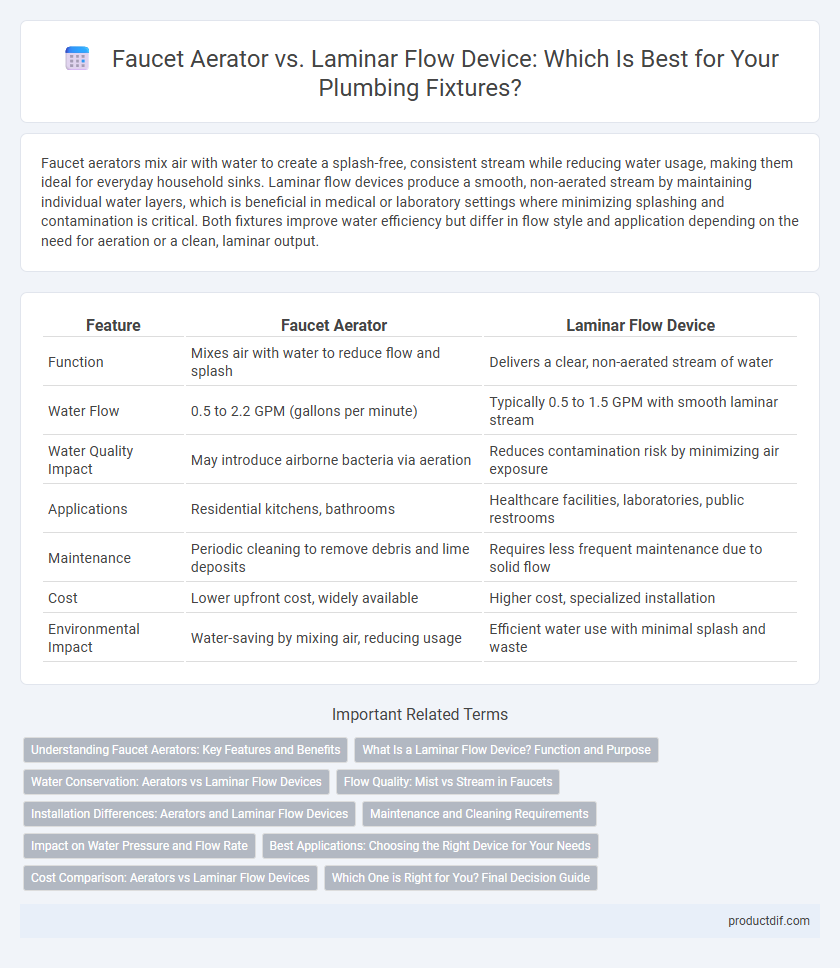Faucet aerators mix air with water to create a splash-free, consistent stream while reducing water usage, making them ideal for everyday household sinks. Laminar flow devices produce a smooth, non-aerated stream by maintaining individual water layers, which is beneficial in medical or laboratory settings where minimizing splashing and contamination is critical. Both fixtures improve water efficiency but differ in flow style and application depending on the need for aeration or a clean, laminar output.
Table of Comparison
| Feature | Faucet Aerator | Laminar Flow Device |
|---|---|---|
| Function | Mixes air with water to reduce flow and splash | Delivers a clear, non-aerated stream of water |
| Water Flow | 0.5 to 2.2 GPM (gallons per minute) | Typically 0.5 to 1.5 GPM with smooth laminar stream |
| Water Quality Impact | May introduce airborne bacteria via aeration | Reduces contamination risk by minimizing air exposure |
| Applications | Residential kitchens, bathrooms | Healthcare facilities, laboratories, public restrooms |
| Maintenance | Periodic cleaning to remove debris and lime deposits | Requires less frequent maintenance due to solid flow |
| Cost | Lower upfront cost, widely available | Higher cost, specialized installation |
| Environmental Impact | Water-saving by mixing air, reducing usage | Efficient water use with minimal splash and waste |
Understanding Faucet Aerators: Key Features and Benefits
Faucet aerators mix air with water to reduce flow rate while maintaining pressure, improving water efficiency and minimizing splashing. These devices typically feature screens and valves that create a soft, non-splashing stream, enhancing user comfort and reducing water consumption. Aerators also help filter debris and prevent sediment buildup, extending the lifespan of plumbing fixtures.
What Is a Laminar Flow Device? Function and Purpose
A laminar flow device is a plumbing fixture component designed to create a smooth, non-turbulent stream of water by channeling flow through multiple parallel tubes, promoting a consistent and splash-free output. Unlike faucet aerators that mix air with water to reduce flow and enhance water feel, laminar flow devices maintain a solid, clear stream ideal for hygiene-sensitive environments like hospitals. Their primary function is to prevent the spread of aerosols and contaminants, ensuring clean water delivery with minimal turbulence.
Water Conservation: Aerators vs Laminar Flow Devices
Faucet aerators mix air with water to reduce flow rate, achieving significant water conservation while maintaining pressure and spray pattern. Laminar flow devices create a non-aerated, solid stream that minimizes splashing and reduces water use but may use slightly higher flow rates compared to aerators. Both devices contribute to efficient water management, with aerators optimized for reducing consumption and laminar flow devices suited for precision applications requiring clear, splash-free streams.
Flow Quality: Mist vs Stream in Faucets
Faucet aerators mix air with water to create a controlled mist that reduces water usage while maintaining pressure, resulting in a soft, splash-free flow ideal for everyday use. Laminar flow devices produce a clear, non-aerated stream that maintains water quality by preventing airborne contaminants, making them suitable for healthcare and laboratory environments. The choice between aerators and laminar flow devices impacts flow quality significantly, balancing water conservation with hygienic considerations.
Installation Differences: Aerators and Laminar Flow Devices
Faucet aerators typically screw onto the faucet spout and require simple hand-tightening or minimal tools for installation, making them user-friendly for most plumbing setups. Laminar flow devices, often found in healthcare or laboratory settings, demand precise installation to maintain a non-turbulent, bead-like water stream, sometimes necessitating specialized fittings or adaptors. Understanding these installation differences ensures proper function, water conservation, and compliance with specific plumbing codes or hygiene standards.
Maintenance and Cleaning Requirements
Faucet aerators require regular cleaning to prevent mineral buildup and maintain optimal water flow, often involving simple removal and soaking in vinegar. Laminar flow devices typically have fewer maintenance needs since they do not mix air with water, reducing the risk of clogging and buildup. Both fixtures benefit from periodic inspection, but aerators generally demand more frequent attention to sustain performance.
Impact on Water Pressure and Flow Rate
A faucet aerator mixes air with water, creating a softer flow that reduces water pressure but maintains a higher flow rate ideal for everyday tasks. A laminar flow device produces a clear, non-splashing stream by channeling water in parallel layers, often resulting in a lower flow rate with consistent pressure. Choosing between these affects both water efficiency and user experience, with aerators favoring flow rate and laminar devices prioritizing pressure stability.
Best Applications: Choosing the Right Device for Your Needs
Faucet aerators are ideal for residential and commercial applications where water conservation and splash reduction are priorities, as they mix air with water to create a soft, aerated stream. Laminar flow devices are best suited for healthcare facilities and laboratories, providing a clear, non-aerated water stream that minimizes contamination risks and maintains water pressure. Selecting the right device depends on water efficiency goals, hygiene requirements, and the desired water flow characteristics specific to the environment.
Cost Comparison: Aerators vs Laminar Flow Devices
Faucet aerators are generally more cost-effective, with prices typically ranging between $5 and $20, making them an affordable choice for most plumbing fixtures. Laminar flow devices, designed to produce a smooth, splash-free water stream, often cost between $15 and $50 due to their specialized construction and advanced technology. The higher initial investment in laminar flow devices may be justified by improved water efficiency and hygiene, especially in commercial or healthcare settings.
Which One is Right for You? Final Decision Guide
Faucet aerators mix air with water to reduce flow rate while maintaining pressure, ideal for energy savings and splash reduction in everyday use. Laminar flow devices produce a clear, non-aerated, bubble-free stream, perfect for healthcare or laboratory settings requiring sterile conditions. Choose an aerator for efficient water conservation in residential or commercial applications, or opt for a laminar flow device when hygiene and precision are critical.
Faucet aerator vs Laminar flow device Infographic

 productdif.com
productdif.com